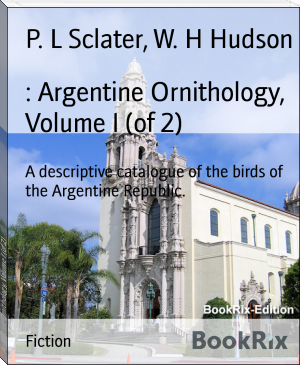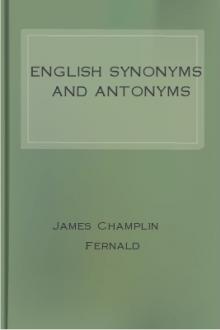: Argentine Ornithology, Volume I (of 2), P. L Sclater, W. H Hudson [best authors to read txt] 📗

- Author: P. L Sclater, W. H Hudson
Book online «: Argentine Ornithology, Volume I (of 2), P. L Sclater, W. H Hudson [best authors to read txt] 📗». Author P. L Sclater, W. H Hudson
breast, and upper belly scarlet; sides of belly and crissum with
brownish edgings to the black feathers; under wing-coverts white;
bend of the wing red; slight rictal stripe white; bill horn-colour;
feet brown: total length 10·0 inches, wing 4·7, tail 3·6. _Female_
similar.
_Hab._ Chili, Patagonia, and Falkland Islands.
Two species of _Trupialis_ inhabit the southernmost part of the
Argentine Republic, the present being confined to Patagonia and South
Chili, while its northern representative inhabits the pampas of Buenos
Ayres and Uruguay. Probably the Colorado River, which separates two
districts differing in soil and vegetation, is the boundary-line
dividing their habitats. So nearly alike are these two birds in colour,
language, and habits, that they seem rather like races than species; and
they were so regarded by naturalists until recently, when the pampas
bird was raised to the rank of a distinct species, with the name of
_Trupialis defilippii_. Unfortunately the old name _militaris_ fits the
Pampas, and not the Patagonian, Starling best; but of this I shall speak
when I describe the former species.
In form and size _T. militaris_ resembles the Common Starling of Europe,
but differs from it in habits, flight, language, and in colouring; its
upper plumage being fuscous mottled with yellowish grey, the throat
and bosom scarlet inclining to crimson. This hue varies greatly, the
breast-feathers being often tipped with white, which subdues the intense
red, and gives it a rosy tint in some individuals. The female is
paler-plumaged than the male, and has less red on the breast.
It inhabits the whole of Patagonia to the Strait of Magellan, but is
confined to the valleys or to the neighbourhood of water; and Durnford
remarks that it is a useful bird to the traveller in that thirsty
country, as its presence is a sure indication of water. It is resident,
and is seen in small parties of four or five, or in small flocks seldom
exceeding twenty or thirty in number. It feeds and lives on the ground,
and only occasionally is it seen to perch on a low bush. Its flight is
strong, and it flies about a great deal, and usually utters its song
when on the wing. The song is continued all the year, and is heard
even on the coldest days in winter; the notes are few and not highly
melodious, but are cheerful and vigorous.
The nest is made of dry grass and rootlets attached to the rushes in
moist ground, and placed close to or resting on the surface. The eggs
are five, the ground-colour white spotted or blotched with reddish
brown.
104. TRUPIALIS DEFILIPPII, Bp. (DE FILIPPI'S MARSH-STARLING.)
+Sturnella defilippii+, _Scl. et Salv. P. Z. S._ 1869, p. 161 (Buenos
Ayres); _iid. Nomencl._ p. 38; _Döring, Exp. al Rio Negro, Zool._
41 (Pampas); _Barrows, Bull. Nutt. Orn. Cl._ viii. p. 136(Pampas south of Buenos Ayres). +Trupialis defilippii+, _Scl.
Cat. B._ xi. p. 357. +Trupialis militaris+, _Burm. La-Plata
Reise_, ii. p. 490 (Rosario, Paraná).
_Description._--Like _Tr. militaris_, but rather smaller, and with
the under wing-coverts black.
_Hab._ Northern Argentina and Uruguay.
Throughout the country where this species abounds it is called _Pecho
colorado_, which is certainly better than Azara's barbarous, if
picturesque, name of _Degollado_; but no happier name than _militaris_
could have been invented for it, by which it was formerly known to
naturalists; and though it was given to the bird merely on account
of the red breast, and was therefore equally applicable to all the
red-breasted species on the globe, in this case it accidentally seemed
to describe a peculiar habit of the bird, as well as its bright livery.
In size, form, gait, flight, language, and colour the present bird very
closely resembles the Patagonian Starling; but the crimson on the breast
is brighter and the upper parts are darker. Its nesting-habits are also
like those of the southern bird; the number and colour of the eggs being
the same in both species. One trivial difference in habit is that De
Filippi's Starling occasionally soars up a few yards into the air when
uttering its song. It inhabits the moist grassy pampas in the southern
part of the Buenos Ayrean province, and is there abundant and unites in
large flocks. At the approach of the cold season there is a general
movement northwards of the birds, which does not, however, extend far,
as the birds, although strong fliers, travel slowly and in a peculiar
manner; it is in this season, when the birds are seen moving in large
flocks, that the name of Military Starling strikes one as being
peculiarly appropriate. They do not journey through the air like other
migrants, but move over the ground, when the flock, composed of four or
five hundred to a thousand or more individuals, is extended so as to
present a very long front, and at intervals the hindmost birds fly over
the others and alight just in advance of them: the long front, the
precision of their movements, and their scarlet bosoms all turned one
way, suggest the idea of a disciplined army on its march.
They never perch on trees, but frequently alight on the roof of a rancho
or other elevation affording a secure footing. They are tame birds and
fly reluctantly; when approached, they usually crouch down, hiding their
crimson bosoms, and remain motionless in order to escape observation.
In disposition they are peaceful, and so fond of society that when one
becomes separated from his fellows he will unite with birds of another
kind, even with Plovers or Tyrant-birds.
On the great monotonous plains, where most of the small birds are grey-
or brown-plumaged, and in winter when there are no flowers to satisfy
the desire of the eye for bright colour, it is delightful, while
travelling, to meet with an army of these Starlings: their crimson
bosoms, less bright than the hues of some tropical species, seem then
to glow with a strange splendour on the sombre green of earth, and the
sight produces an exhilarating effect on the mind.
105. ICTERUS PYRRHOPTERUS, Vieill. (CHESTNUT-SHOULDERED HANG-NEST.)
+Icterus pyrrhopterus+, _Scl. et Salv. P. Z. S._ 1868, p. 140; _iid.
Nomencl._ p. 36; _Hudson, P. Z. S._ 1870, p. 88 (Buenos Ayres);
_Durnford, Ibis_, 1878, p. 59; _Salvin, Ibis_, 1880, p. 356
(Salta); _Barrows, Bull. Nutt. Orn. Cl._ viii. p. 133 (Entrerios);
_Scl. Cat. B._ xi. p. 368. +Xanthornus pyrrhopterus+, _Burm.
La-Plata Reise_, ii. p. 493 (Paraná, Tucuman).
_Description._--Uniform black; upper lesser wing-coverts chestnut;
bill black; feet dark brown: whole length 7·7 inches, wing 3·6,
tail 3·8. _Female_ similar, but smaller.
_Hab._ S. Brazil, Paraguay, Bolivia, and Argentina.
This interesting bird, the only _Icterus_ found in the Argentine
Republic, ranges south to Buenos Ayres, where it is migratory, and
appears in small flocks of six or eight individuals in September; but
soon after arriving these little companies break up, and the birds are
subsequently found singly or in pairs in the woods along the Plata
River.
The sexes are alike in colour, but the male is considerably larger;
the whole plumage is an intense black, excepting a rufous spot on the
shoulder, seen only when the bird is on the wing; the bill is black and
curved, the body slender, and the tail long. It is a loquacious bird,
most of its tones being low and pleasing; exceedingly restless in
disposition, incessantly passing from tree to tree, jerking its long
tail and clinging to the branches in various attitudes, while searching
for insects in the decayed bark. While thus engaged it utters a great
variety of chirping and guttural sounds, interspersed with short
agreeable notes. It also has a song of considerable merit, low and
varied in tone, with a peculiar ventriloquism in many of the notes which
produce a confusing idea on the listener that the bird approaches
and recedes alternately whilst uttering them. While singing the bird
continues moving, but always concealed in the thick foliage, and it is
probably this constant turning about of the singer, and the notes coming
through leafy screens of varying density, which makes the ventriloquism
and gives so much light and shade to its mysterious melody.
The first bird of this species I shot was wounded very slightly in one
wing and fell into a stream; to my very great surprise it began singing
its usual song while floating about on the surface, making no attempt
to swim. After fishing it out it continued to sing at intervals in my
hand: how strange it was to hear this bleeding captive bird warbling out
soft, sweet notes which seemed to express only pleasant emotions! Yet
it was evident that the bird was fully alive to its danger, for it
struggled violently to escape and bit my finger savagely with its sharp
beak.
I subsequently found a nest; it was about seven inches deep, composed
entirely of lichens gathered from the boles of trees, ingeniously woven
together and suspended from the small twigs and leaves at the extremity
of a branch. There were no eggs in it, but the birds fluttered in great
trouble about me, and, what greatly surprised me, uttered a variety
of _singing_ notes, unlike their usual song, but many of them closely
resembling the notes of other songsters, which made me think that this
_Icterus_ possesses the mimicking faculty to some extent. This, however,
is a question it would be difficult to decide. It seems certain,
however, that this species is incapable of expressing any distressing
feeling, such as pain, fear, or parental anxiety, with loud harsh notes
like other birds. It is much to be regretted that Azara, who found this
species common in Paraguay, did not pay more attention to its habits and
language, which make it specially interesting even in a family so rich
in strange habits as the _Icteridæ_.
106. APHOBUS CHOPI (Vieill.). (CHOPI BOAT-TAIL.)
+Chopi+, _Azara, Apunt._ i. p. 282. +Aphobus chopi+, _Scl. Cat. B._
p. 405. +Psarocolius unicolor+, _Burm. La-Plata Reise_, ii. 494 (Mendoza).
_Description._--Uniform black, slightly resplendent; bill and feet
black; lower mandible sulcated: whole length 9·2 inches, wing 5·2,
tail 4·0. _Female_ similar, but smaller and duller; bill not
sulcated.
_Hab._ S. Brazil, Paraguay, Argentina, Bolivia, and Peru.
The Chopi, which is said to be quite common in Paraguay, is only found
in the north-eastern part of the Argentine Republic, consequently I have
never seen it, except as a cage-bird; nor is there anything about it in
the notes of recent collectors and travellers who have visited the upper
waters of the Plata. This is, however, not to





Comments (0)